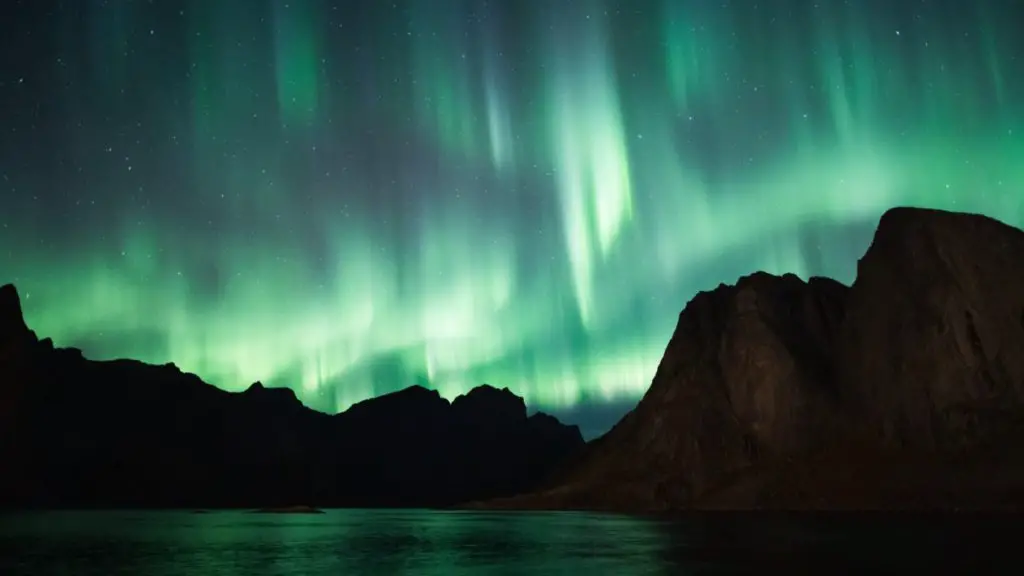
For those of us that have been lucky enough to witness the otherworldly light shows put on display by mother nature, have you ever wondered where these cascades of blooming colors came from and what they really mean?
Here is a guide on everything you could possibly want to know about the aurora!
Aurora Borealis and the Northern Lights
The Auroras have most commonly been known by names such as the Northern Lights or Aurora Borealis. As intuitive as some of these names, let’s take a look at where they originated from and what they mean.
The term Aurora Borealis was coined in 1619 by the Italian astronomer Galileo Galilei for the astrophysical phenomenon he observed in the northern skies.
The word “Aurora” was derived from the Latin word for dawn, which was also the ancient Roman equivalent of Eos – the Greek goddess of dawn. And the name “Borealis” was derived from the Latin word “Boreas,” who was the ancient Greek god of the northern winds.
From that alone, it may seem pretty obvious where the Northern Lights received its name, but what may not be common knowledge tell us that the Northern Hemisphere is not the only place we can find such a magnificent display of flames in the sky.
The Southern Hemisphere’s auroras were given the name Southern Lights, or otherwise known as Aurora Australis, where the Latin word “Australis” means “southern.”
What is an aurora?
An aurora is a natural display of lights that shine colors blue, red, yellow, green, and orange, which shifts like gently blowing curtains.
Although auroras also occur during the day, they are only visible at night and only appear near the two polar regions.
How are auroras formed?
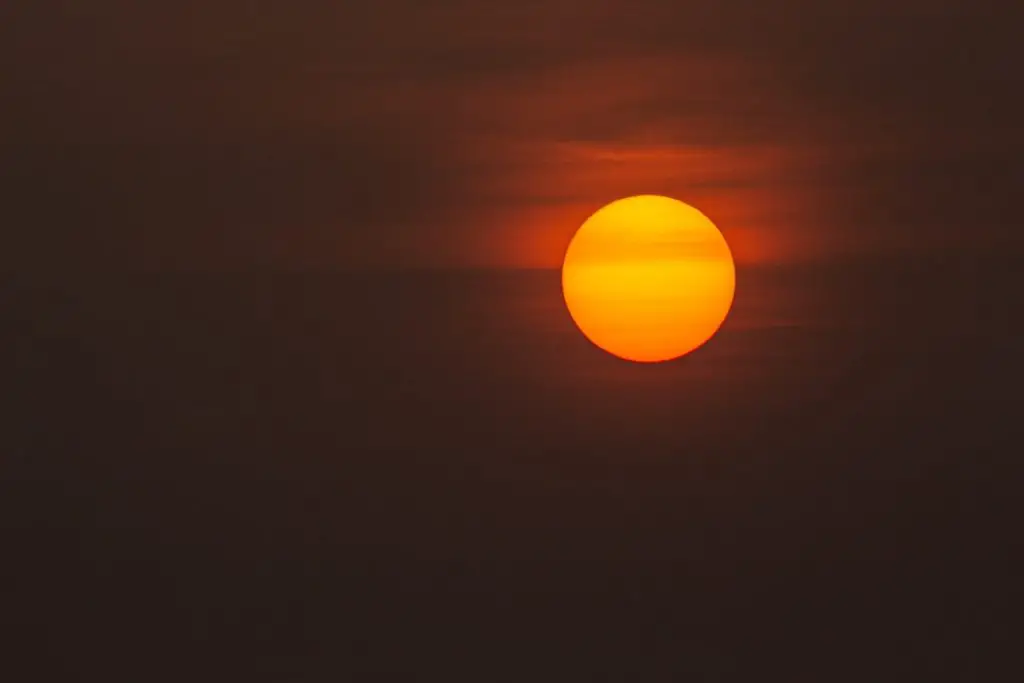
The search for the origins of the auroras with no surprise has led us back to the source of all life: The Sun.
You have to be patient with me. To understand the Sun’s role in producing such a poetic display of dancing lights, we first have to grasp our star’s inner workings.
As the solar system’s powerplant, all of the energy produced originates from the Sun’s core, which makes up the innermost 25% of the solar interior. This environment is where the immense gravitational force pressurizes hydrogen atoms into helium through nuclear fusion.
As the helium atoms heat up, they break apart into electrons and ions, which make up the hot and dense plasma of the Sun. The energized plasma movement helps produce electrical currents that generate the stellar magnetic field of the Sun.
The somewhat fluid interior and exterior of the Sun results in rotational direction and speeds that differ based on varying latitudes and longitudes. And just like rubber bands, the magnetic field lines generated by these convection currents can become wound up and tangled together to create an area of highly concentrated magnetic field flux. This phenomenon is referred to as a sunspot and can appear as dark blotches on the solar surface.
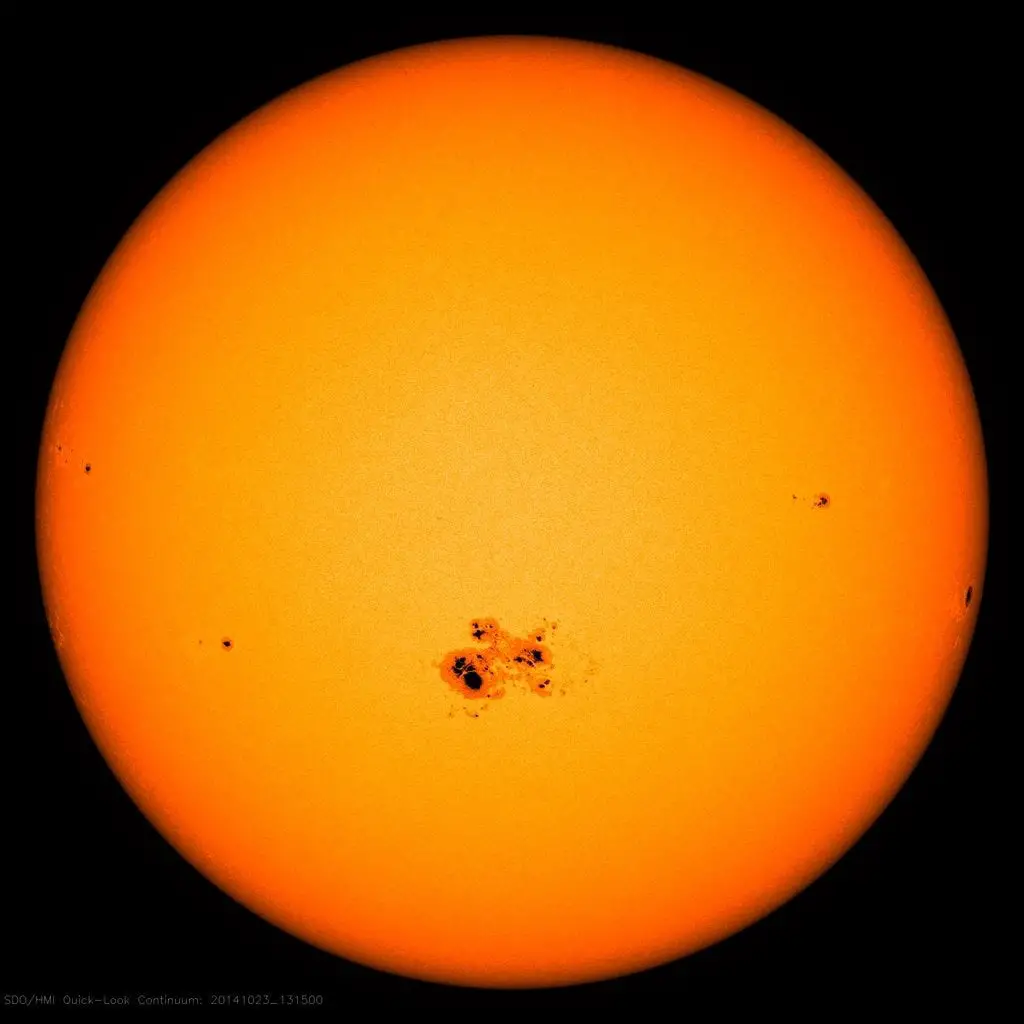
Due to the Sun’s differential rotation, its geomagnetic poles have been estimated to reverse every 11 years at the peak of solar activity, which scientists have dubbed the solar cycle.
With a somewhat rudimentary understanding of the Sun’s magnetic field, let’s turn our gaze towards the solar wind – a hot, supersonic flow of energized plasma from the Sun that consists primarily of electrons and protons, which also carries an embedded magnetic field.
This solar wind expands outwards from the Sun’s corona (upper atmosphere) at speeds up to 900 km/s with a temperature of 1 million degree Celsius (depending on the solar longitude and latitude). As the Sun rotates fully every 27 days, this winds up the magnetic field lines into a rotating spiral that extends radially outwards, which releases a constant stream of “wind” as the plasma travels out accordingly.
These emissions often result in bright solar patches on the corona, which are aptly named “corona holes”.
After approximately 4 days, the solar wind arrives at Earth and has an encounter with our magnetosphere.
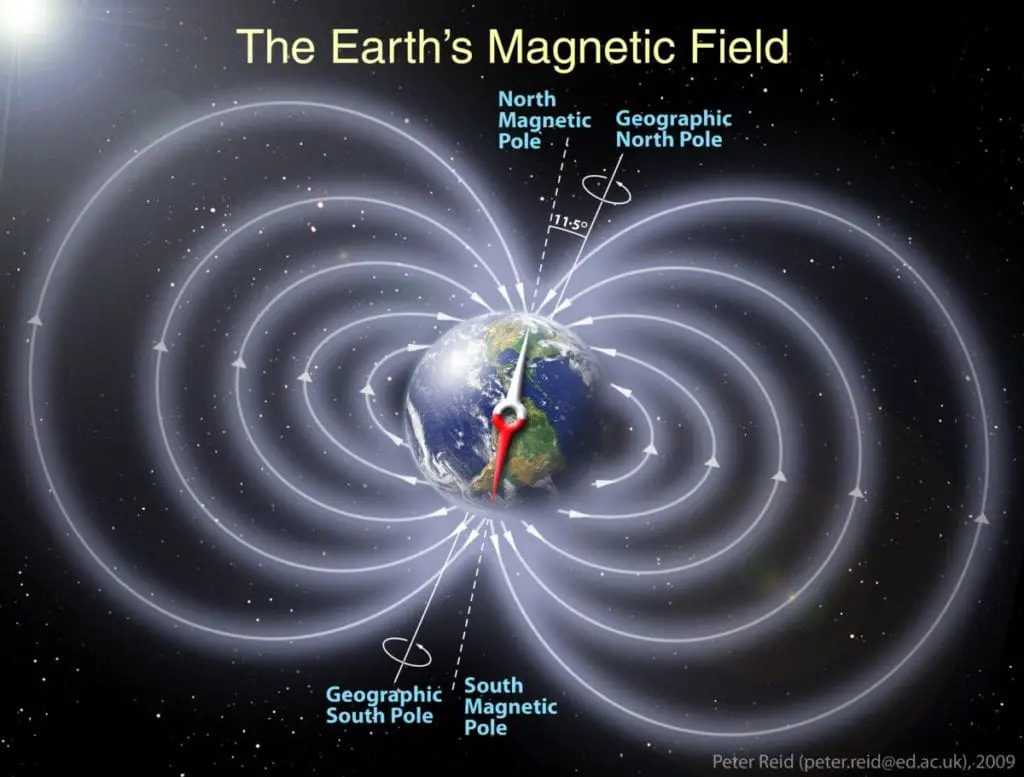
Without the magnetosphere, the solar wind would blow away our atmosphere with no remorse and effectively end all life on Earth. But thankfully, most solar wind particles are deflected and are forced to continue traveling out into the solar system.
However, for the unlucky few that became trapped in the Earth’s magnetic field lines, they are forced to enter the atmosphere through a region centered around the magnetic North and South Poles called the ionosphere.
The charged particles of the solar wind plasma collide with the atoms present in the atmosphere, and these collisions boost them to specific energy levels. As the atoms return to their resting state, they emit electromagnetic radiation that corresponds to different wavelength on the visible light spectrum. Or, in layman’s terms – collision makes color, and humans named this phenomenon auroras.
What gives an aurora its color?
First, all gases shine with their own unique color, and no gas gives off the same color.
The colors of the aurora depend solely on the composition of gases in the Earth’s atmosphere, density, altitude, and energy level from the Sun.
When the charged particles of the solar wind strike the atmosphere, the atoms that make up the gases become excited. As they return to their original energy levels, electromagnetic radiation is released, which corresponds to different wavelengths on the visible light spectrum. The colors produced are then dependent on the altitude and the concentration of the atoms at that height.
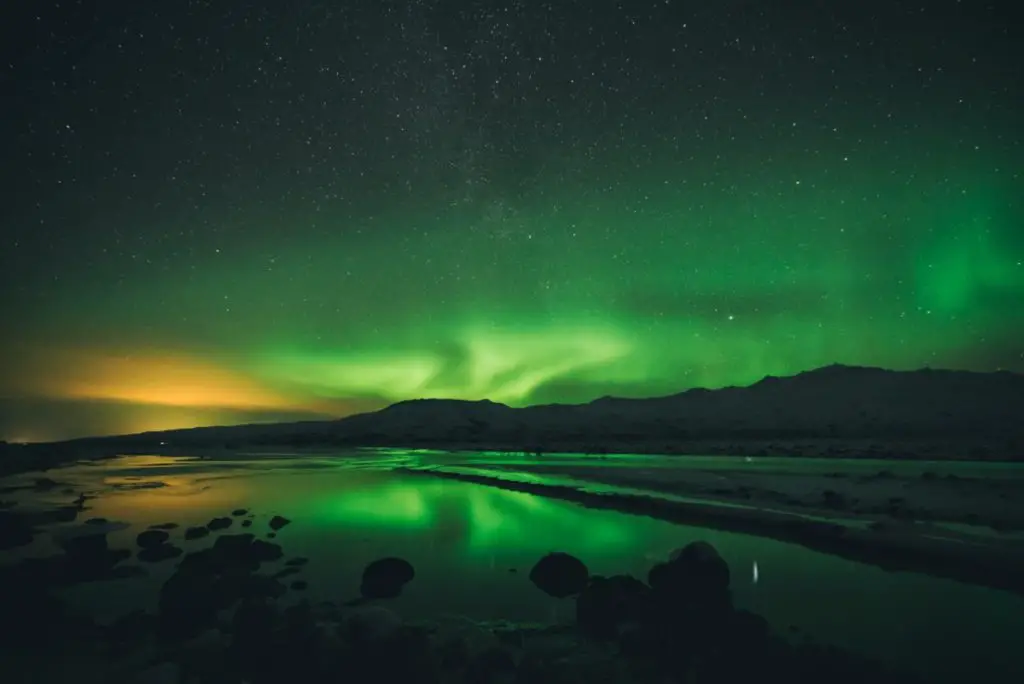
Red Glow
- The solar wind strikes oxygen atoms at an altitude of 300-400 km.
- The wavelength for red is 630 nm.
- The atmosphere is less dense at this altitude. A lower concentration of oxygen atoms results in less frequent collisions and less energy. As such, it takes more time (up to 2 min) to produce the red glow.
- The lowered sensitivity of human eyes to the color red makes it only visible under intense solar activity conditions.
Green Glow
- The solar wind strikes oxygen atoms at an altitude of 100-300 km.
- The wavelength for green is 557.5 nm.
- The atmosphere is denser at this altitude. A higher concentration of oxygen atoms results in more frequent collisions and thus higher energy. As such, it takes less time (~1 second) to produce the green glow.
- The heightened sensitivity of human eyes to the color green makes it easily visible for viewing.
- Red and Green can often mix to produce yellow hues.
Blue Glow
- At an altitude below 100 km, nitrogen becomes responsible for producing the visible glow of the auroras.
- The wavelength for blue is 428 nm.
- The mixture of atomic oxygen and nitrogen (the colors red, green, and blue) can result in purple, pink, or crimson light that becomes gradually visible with increasing solar activity.
What gives an aurora its shape?
Auroras generally form bands that align in a magnetic east to west direction. The shimmering rays that we see result from auroral electrons traveling along the magnetic field lines into the atmosphere.
Two Distinct Classifications of Auroras
Arcs
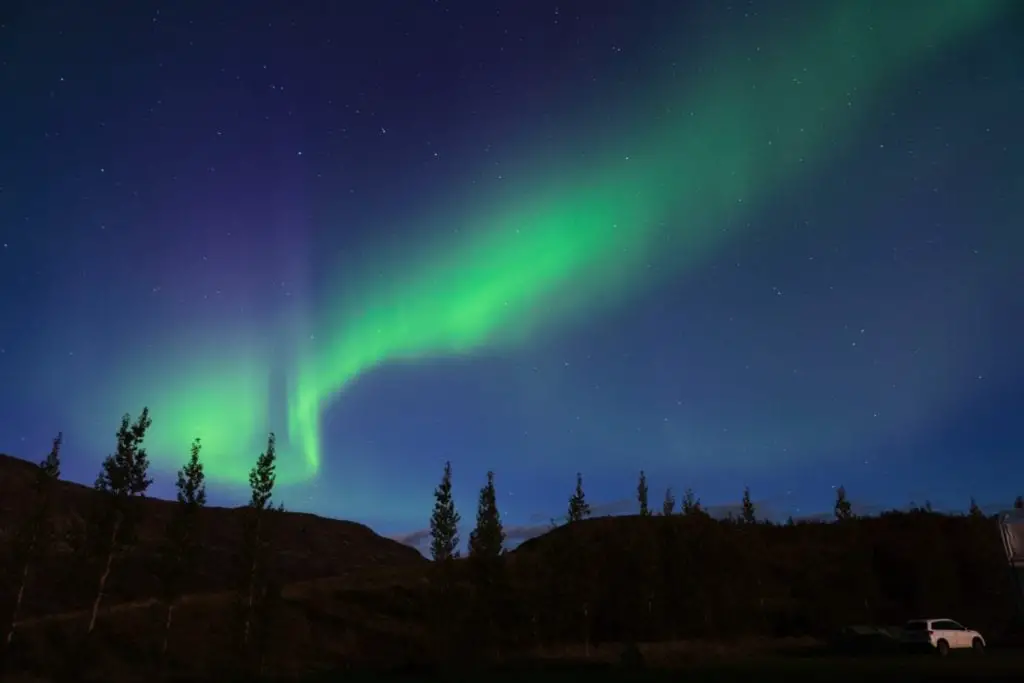
The arc classification is discrete bands formed due to electrons accelerating into the Earth’s atmosphere when the magnetic field is trying to reconfigure itself due to stretching by the solar wind. It can include shapes such as curtains, bands, rays, etc.
Patchy and Pulsating
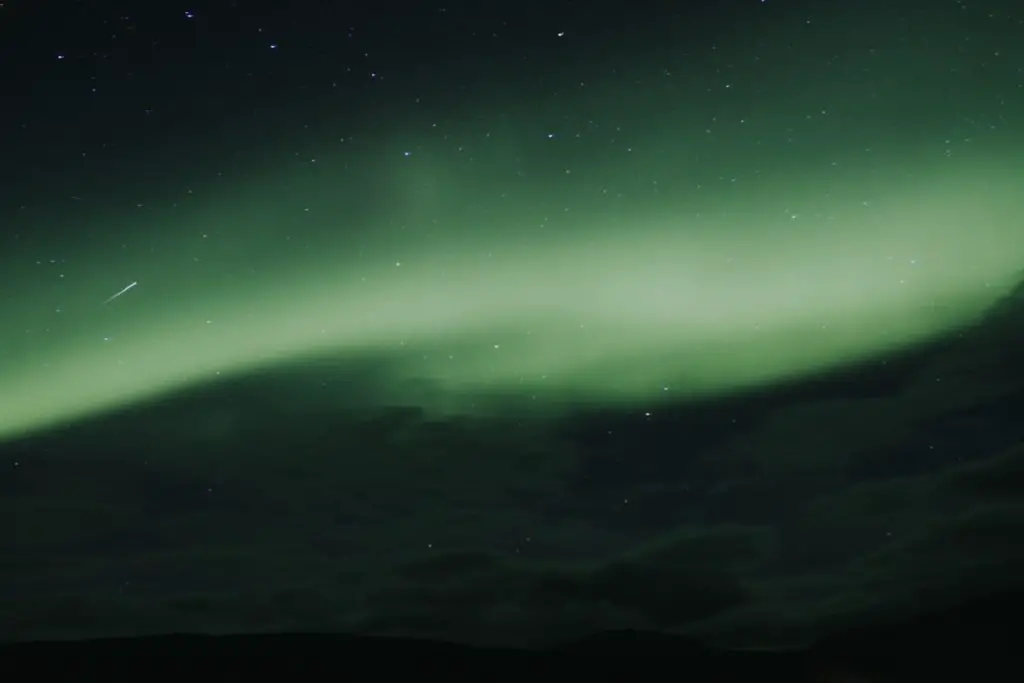
This classification appears as a patch of light or a veil across the sky. It results from plasma waves known as whistlers scattering ions into the atmosphere as opposed to accelerating like a dive bomber.
Common Shapes of Auroras
- Curtains – The most common type of auroras formed by rayed bands appear to drape and hang in waves across the sky when viewed from a distance.
- Arcs – This is a curve of light with a smooth lower border. Auroral displays generally start as arcs and stretch horizontally for thousands of kilometers.
- Bands – This is an arc with an irregular lower border that curves and twists instead of being smooth.
- Rays – Rays may be seen as pillars of light stretching upwards or rays of light shooting downwards, depending on your unique perception. Rays may also appear to move or pulsate.
- Coronae – Named after a crown, you can only imagine what a coronae may look like when it’s above you. Generally only seen with overhead auroral activity, the coronae may look like a starburst that converges to a zenith, similar to what we see when looking up at a skyscraper standing directly underneath it.
- Patches – Patches are less concentrated glows that don’t form bands across the sky but pulsate in brightness. These are generally less common than arcs.
How long does an auroral display last?
The short answer is:
Anywhere between 10 minutes to as long as the sky is dark!
The length of auroral displays mostly depends on the magnitude of the incoming solar wind and weather conditions on Earth, such as a dark, clear sky and away from light pollution.
Make sure to check both the solar and weather forecast when you start planning for your next trip!
When can I see the most auroras?
Most auroras occur when the solar winds are the strongest. This depends on the sun’s amount of solar activity, tracked over an 11-year solar cycle that begins and ends with a geomagnetic reversal (the poles flip!).
Since the magnitude of solar wind we receive depends on the amount of solar activity, let’s take a look at what causes the Sun to “move”!
High Sunspot Activity
Understandably, the Sun is a huge ball of electrically charged hot plasma. This plasma is always moving, but oftentimes not with the same speed or in similar directions. This causes the magnetic fields generated by the moving plasma to stretch, which often twists and become tangled together.
The resulting magnetic fields from such an orientation are known as sunspots, which are areas that appear darker on the solar surface. Such patches’ magnetic forces are so strong that the heat and plasma become contained and are prevented from reaching the surface, resulting in a much cooler temperature.
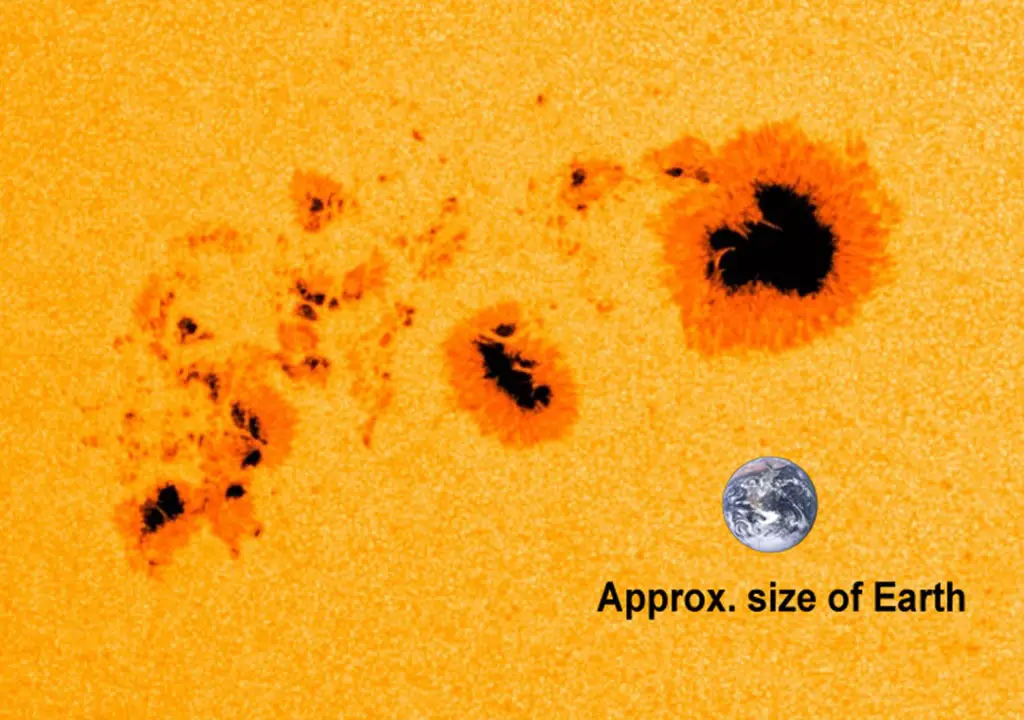
With this knowledge, the brightest and most consistent auroral displays can be found during times of high sunspot activities.
Solar activity can be tracked at Space Weather Live.
Two phenomenons have also been known to occur during these periods that relate to more intense and radiating sightings of auroras: Solar Flares and Coronal Mass Ejections (CME).
Solar Flares
As the Sun rotates non-uniformly, the magnetic field lines cross, and tangles then reorganize. Solar flares are giant explosions that result from the sudden release of energy from the reorganization in the Sun’s magnetic field.
These intense bursts of radiation can last anywhere from minutes to hours. The radiation is sometimes so intense it can interfere with radio equipment back on Earth.
Coronal Mass Ejections (CME)
Coronal Mass Ejections, similar to solar flares, are giant explosions of radiation that shoot high into space at breakneck speeds, except that CMEs also release matter that contains gas and magnetized plasma.
CMEs oftentimes also occur simultaneously with solar flares and is also the result of the reorganization of the Sun’s magnetic field lines.
Spring and Autumn Equinox
The Spring and Autumn Equinox are two moments in the Earth’s orbit with a 23-degree polar tilt that aligns the Sun right above the Equator. This makes the sun equidistant from both poles, which results in a night and day of equal length.
At this position, the Earth’s magnetic field is perfectly oriented to “connect” with the sun, leading to an increased flux of solar winds and magnetic storms.
Such an influx of solar winds can result in auroral displays in the midlatitudes, which goes as far south as the Yucatan peninsula in Mexico! I don’t even want to begin imagining the lights that could be seen near the polar poles!
The date and time for the equinoxes may differ based on timezone and the orbit of Earth around the Sun, so make sure you do your research before making any plans!
Stages of Solar Cycle
This 11 year cycle begins and ends with the solar minimum.
Solar Minimum – This is the beginning of the solar cycle with the smallest number of sunspots, which increases until the solar maximum.
Solar Maximum – Occurs during the middle of the solar cycle with the most sunspots, decreasing until the solar minimum, and the cycle begins again.
As you can imagine, your best chances of catching the most magnificent displays of dancing lights in the sky are the years leading up to and during the solar maximum.
We currently reside in the 25th solar cycle – a solar minimum, as the solar activity during cycle 24 has reached an all-time low in April 2020. However, two European researchers rebutted this decision and published a peer-reviewed paper, which stated the new cycle actually began in November/December of 2019.
This rebuttal was agreed upon by the Solar Cycle 25 Prediction Panel, which officially declared Solar Cycle 25 to have begun in December 2019.
Either way, the next solar maximum is predicted to occur in July 2025. Like cycle 24, solar activity for cycle 25 would still be weaker than average, with fewer sunspots overall.
Best Months to Go Chasing Auroras
The best time to take your next vacation for the magnificent auroras is the wintertime when the nights are longest, which not surprisingly occur at different months for the North and Southern hemisphere.
Northern Hemisphere
- September-March (Peak Season)
- Spring Equinox (Late March)
- Autumn Equinox (Late September)
Southern Hemisphere
- May-August
- Spring Equinox (Late September)
Where can I find auroras?
According to National Geographic, “auroras are visible almost every night near the Arctic (North Hemisphere) and Antarctic (South Hemisphere) Circles, which are about 66.5 degrees north and south of the Equator.” This generally equates to a radius of 2500 km around the magnetic poles known as the auroral zone or the auroral oval.
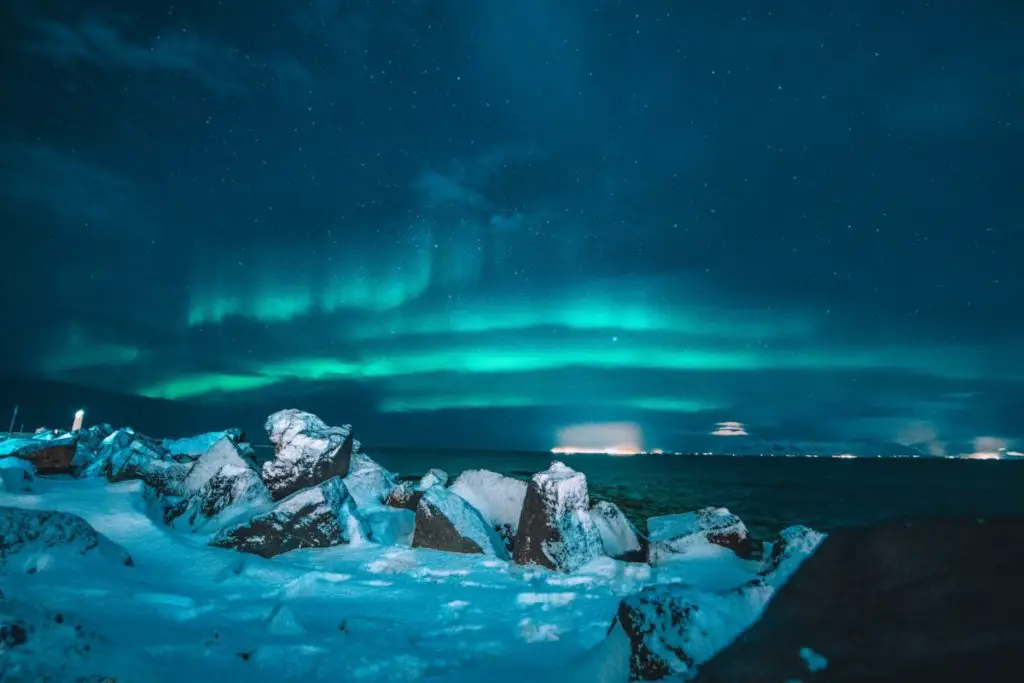
Here is a list of locations around the world where you can best witness mother nature’s free light show:
Northern Hemisphere
Iceland (Aurora Forecast)
- Reykjavík (away from the city)
- Thingvellir National Park
- Hella
- Hotel Rangá
- Jökulsárló Glacial Lagoon
- Skógar
- Snaefellsnes
Scotland (Aurora Forecast UK)
- Hebrides
- Caithness Coast
- Orkneys
- Shetland
- Aberdeenshire and Moray Coast
- Isles of Lewis and Harris
- Skye (Northernly Tip)
- The Cairngorms
- Galloway Forest Park
- Angus and Coast of Fife
- Calton Hill or Arthur’s Seat in Edinburgh (only if the aurora is really strong)
Sweden
- Laplands
- Kiruna
- Abisko National Park – Aurora Sky Station
- Village of Jukkasjärvi
- Porjus, Laponia
Northern Finland
- Lake Inari
- Rovaniemi
- Arctic Treehouse Hotel
- Santa’s Igloos
- Pyhä-Luosto National Park
- Santa’s Hotel Aurora
- Bay of Bothnia
- Kemi Seaside Glass Villas
- Village of Nellim
- Wilderness Hotel Nellim
- Harriniva
- Aurora Dome
- Levi
- Levi Ski Resort Igloos
- Northern Lights Ranch
- Pyhätunturi
- Pyhä Igloos
- Pyhän Asteli Aurora Igloos & Suites
- Lucky Rach Snow Igloos
- Kakslauttanen Arctic Resort Igloos
Canada (Aurora Forecast)
- Yukon
- Dawson City
- Whitehorse
- Nunavut
- Iqaluit
- Northwest Territories
- Yellowknife
- Hay River
- Inuvik
- Manitoba
- Churchill
- Alberta (Dark Sky Preserves)
- Wood Buffalo National Park
- Elk Island National Park
- Jasper National Park
- Rural Cities (on days with high solar activity)
- Cochrane etc.
United States
- Minnesota
- Voyageurs National Park
- Cook County
- Voyageurs National Park
- Northern Idaho
- Idaho Panhandle National Forest
- Maine
- Aroostook National Wildlife Refuge
- Pennsylvania
- Cherry Springs State Park
- Michigan
- Headlands International Dark Sky
- Marquette (Major port on Lake Superior)
- Keweenaw Peninsula
- Alaska (Aurora Forecast)
- Denali National Park
- Fairbanks
- Utqiagvik
- Coldfoot
- Bettles
- Wiseman
- Fort Yukon
- Deadhorse (Prudhoe Bay)
Norway
- Senja
- Svalbard
- Lofoten Islands
- Lyngenfjord Region
- North Cape
- Bodø
- Narvik
- Varanger
- Helgeland
- Tromsø
- Alta
- Vesterålen
Greenland
- Kangerlussuaq
- Sisimiut
- Ilulissat
- Nuuk
- Kulusuk
- Tasiilaq
Southern Hemisphere
Patagonia Region
- Argentina
- Ushuaia
- Chile
- The Falkland Islands
New Zealand
- Steward Island
- Queenstown
Tasmania
- Bruny & Satellite Islands
- Hobart
- Cradle Mountain-Lake St Clair National Park
- Mount Nelson
- South Arm Peninsula
Australia
- Victoria
Antarctica
South Georgia Island & South Sandwich Islands
Remember to always do your own research (the weather, solar weather, amount of light pollution, etc.) before booking a trip!
How can I find an aurora near me?
You can first refer to the list above to see if there are any destinations near you!
If not, then proceed to travel as close as you can to the auroral ovals of both hemispheres, and check for the following conditions:
- Solar Forecast – the more solar activity, the better!
- Away from Light Pollution
- Winter Nights
- Dark and Clear Sky
Do auroras exist on other planets?
Yes! If a planet within our solar system has an atmosphere and a magnetic field, then auroras can exist there! The colors of these auroras, similar to Earth, will largely depend on their atmosphere’s composition.
Here are 4 gas giants that have been observed or predicted to exhibit auroral displays:
Saturn

With magnetic poles as big as the Earth, Saturn’s auroras generally occur in curtain-like manners, although with a different color spectrum.
The solar wind interacts with mainly hydrogen atoms in Saturn’s atmosphere, which results in an aurora that’s purple on top and red at the bottom, as opposed to the red and green auroras we experience on Earth.
The strongest auroras on Saturn would occur in the ultraviolet and infrared wavelength. However magnificent that would be, it is unfortunately not visible to the human eyes.
Jupiter
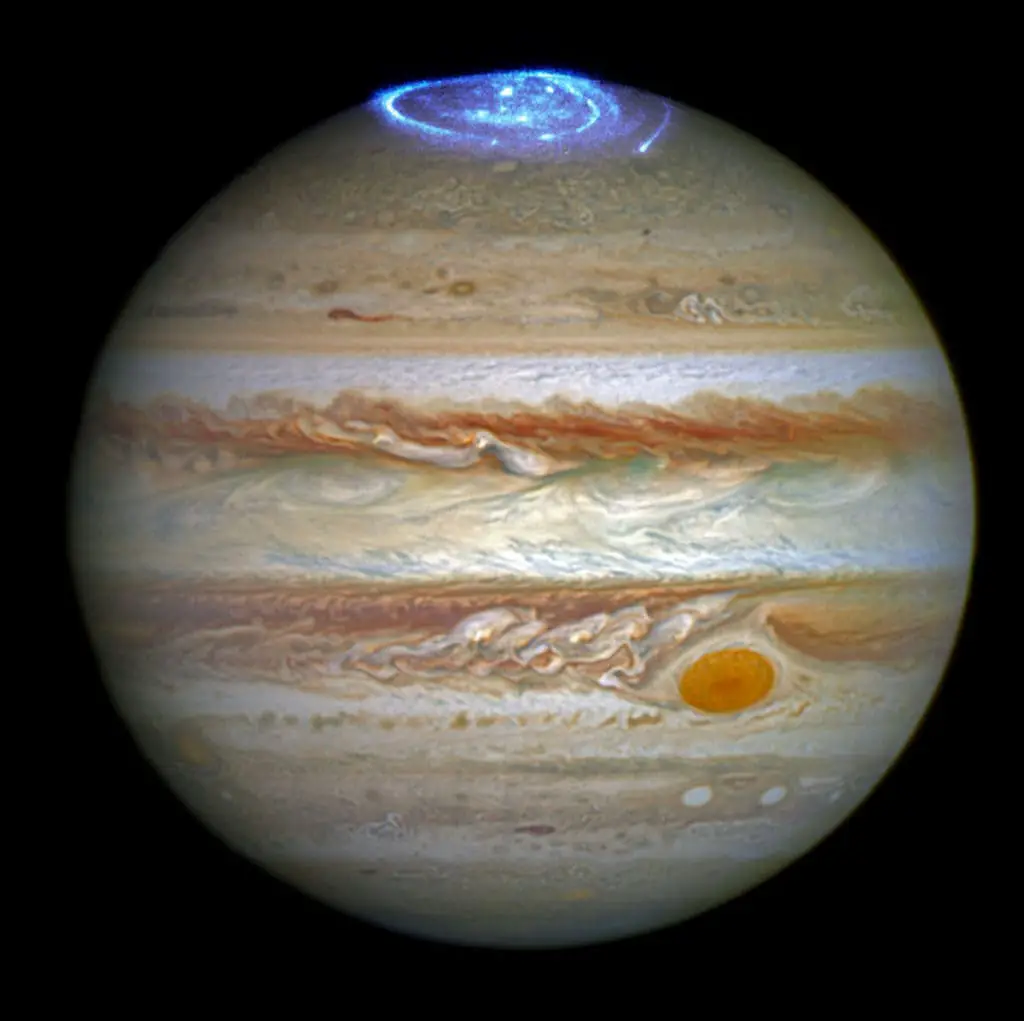
Despite having magnetic poles as big as the Earth, auroras on Jupiter are only visible in the x-ray or ultraviolet wavelength.
Predictions for auroras’ locations are nearly impossible on Jupiter as the pole’s magnetic field interactions are vastly different. When struck by the solar wind, the atoms in the atmosphere also get “excited” to a wider range of energy levels. The resulting wavelength makes it hard to predict where the aurora might be the strongest or weakest as it is erratic and constantly changing.
Uranus

Uranus is unusual as its magnetic axis is 60 degrees different from its spin. Still, the auroral activity is relatively consistent as it mirrors both poles and rotates with the planet.
Neptune
Scientists have actually found Neptune’s magnetic field to be tilted at least 50 degrees from its rotational axis, meaning that it must have a liquid core spinning on a different axis than the outer surface.
It has been said Neptune’s rings actually sweep away most of the solar wind charged particles, which results in fewer auroral displays.
As Neptune’s moons rotate in its rotational equator’s plane, these natural satellites sometimes pass back and forth through the gas giant’s magnetic field. As such, some have predicted that Neptune’s auroral displays may also be triggered by the interaction of Triton’s atmosphere with Neptune’s radiation belts.
Do auroras make sounds?
Yes, auroras do make sounds, but the truth might not be as exciting as you think.
In 2012, a Finnish study proved using an array of microphones to record and pinpoint a hiss’ source during a magnetic storm. The paper’s hypothesis explains that the crackles and pops of the hiss are discharges released when a geomagnetic storm activates the electrical charges in the atmosphere’s inversion layer.
The inversion layer is a region where the temperature actually increases with elevation. When this occurs, the intensity of the electric fields in the air increases due to the generation of a short period of electric pulsation.
The inversion layer is also quite difficult to maintain as even slight winds may break the warm air cap that prevents the cold mass of air below it from mixing with the atmosphere. This explains why auroral sounds can only be heard when the weather is calm.
Are auroras dangerous?
For Humans
To the average human on Earth, these natural light displays are harmless. But for the astronauts out floating about in the vacuum of space, that’s a different story.
The high-speed solar winds from the Sun can seriously injure or kill an unprotected astronaut. The high-energy particles of the solar winds carry immense amounts of radiation poisonous to humans and other mammals.
In the worst-case scenario, such exposure would reach the permissible radiation exposure limit within hours of the event.
For Technology and Infrastructure
Solar flares and coronal mass ejections that strike our atmosphere can cause temporary disturbances to our magnetic field, usually resulting in a geomagnetic storm.
This can cause:
- Disruption to the orbits of satellites and put them at risk of falling to an unnatural death.
- Disruption to high-flying airplanes can interrupt or disconnect their telecommunication and navigation systems (GPS).
- Damage power grid and cause blackouts due to strong electrical currents driven along the Earth’s surface.
- Disruption to spacecraft causing temporary operational anomalies, damage critical electronics, degrade solar arrays, and blind optical systems such as imagers and star trackers.
Best Known Space Weather Event
The best-known space weather event would have to be the Hydro-Québec power network collapse on March 13, 1989. This was due to geomagnetic induced currents (GICs), which resulted in a transformer failure that led to a blackout of more than 9 hours and affect over 6 million people.
The culprit responsible for this is none other than the coronal mass ejection from the Sun on March 9th, 1989. Although, it must have been an impressive array of auroral displays up North.
